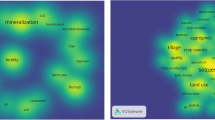Abstract
Soil acidity, nutrient availability and livestock density have a major influence on the belowground ecological community. As fast decomposition rates are due mostly to bacterial-based pathways and slower decomposition rates mostly to fungal-based pathways, it is helpful to condense empirical information in the so-called Nematode Channel Ratio (NCR). The NCR is shown to be a good indicator of efficiency in soil decomposition processes. We argue that in intensive agroecosystems, other fungivore members of the decomposer food web may outcompete the hyphal-feeding nematodes. We demonstrate how the NCR can be used to set ecological standards for sustainable use of the soil in agroecosystems. To summarize the interactions between the microbial resources and the decomposer nematofauna according to increasing land management, we propose the use of the fifth percentile as proxy for a sustainable environmental quality of grasslands on sandy soils, and the NCR mean as the upper threshold for low-stocked farms.



Similar content being viewed by others
References
Ekschmitt K, Bakonyi G, Bongers M, Bongers T, Boström S, Dogan H, Harrison A, Nagy P, O’Donnell AG, Papatheodorou EM, Sohlenius B, Stamou GP, Wolters V (2001) Nematode community structure as indicator of soil functioning in European grassland soils. Eur J Soil Biol 37:263–268
Hedlund K, Santa Regina I, van der Putten WH, Lepš J, Díaz T, Korthals GW, Lavorel S, Brown VK, Gormsen D, Mortimer SR, Rodríguez Barrueco C, Roy J, Smilauer P, Smilauerová M, van Dijk C (2003) Plant species diversity, plant biomass and responses of the soil community on abandoned land across Europe: idiosyncracy or above-belowground time lags. Oikos 103:45–58
Mulder Ch, de Zwart D (2003) Assessing fungal species sensitivity to environmental gradients by the Ellenberg indicator values of above-ground vegetation. Basic Appl Ecol 4:557–568
Mulder Ch, Breure AM, Joosten, JHJ (2003a) Fungal functional diversity inferred along Ellenberg’s abiotic gradients: Palynological evidence from different soil microbiota. Grana 42:55–64
Mulder Ch, de Zwart D, van Wijnen HJ, Schouten AJ, Breure AM (2003b) Observational and simulated evidence of ecological shifts within the soil nematode community of agroecosystems under conventional and organic farming. Funct Ecol 17:516–525
Mulder Ch, van Wijnen HJ, van Wezel AP (2005a) Numerical abundance and biodiversity of belowground taxocenes along a pH gradient across the Netherlands. J Biogeogr 32 (in press)
Mulder Ch, Cohen JE, Setälä H, Bloem J, Breure AM (2005b) Bacterial traits, organism mass, and numerical abundance in the detrital soil food web of Dutch agricultural grasslands. Ecol Lett 8:80–90
Oostenbrink M (1960) Estimate nematode populations by some selected methods. In: Sasser JN, Jenkins WR (eds) Nematology. The University of North Carolina Press, Chapel Hill, NC, pp 85–102
Schouten T, Breure AM, Mulder Ch, Rutgers M. (2004) Nematode diversity in Dutch soils, from Rio to a biological indicator for soil quality. Nematol Monogr Perspect 2:469–482
Sonnemann I, Dogan H, Klein A, Pieper B, Ekschmitt K, Wolters V (1999) Response of soil microflora to changes in nematode abundance—evidence for large scale effects. J Plant Nutr Soil Sci 162:385–391
Wardle DA, Yeates GW, Williamson WM, Bonner KI, Barker GM (2004) Linking aboveground and belowground communities: the indirect influence of aphid species identity and diversity on a three trophic level soil food web. Oikos 107:283–294
Wolters V (2001) Biodiversity of soil animals and its function. Eur J Soil Biol 37:221–227
Wolters V, Silver WL, Bignell DE, Coleman DC, Lavelle P, van der Putten WH, de Ruiter P, Rusek J, Wall DH, Wardle DA, Brussaard L, Dangerfield JM, Brown VK, Giller K, Hooper DU, Sala O, Tiedje J, van Veen JA (2000) Effects of global changes on above- and belowground biodiversity in terrestrial ecosystems: implications for ecosystem functioning. BioScience 50:1089–1098
Yeates GW (2003) Nematodes as soil indicators: functional and biodiversity aspects. Biol Fert Soils 37:199–210
Author information
Authors and Affiliations
Corresponding author
Rights and permissions
About this article
Cite this article
Mulder, C., Dijkstra (1945–2005), J.B. & Setälä, H. Nonparasitic Nematoda provide evidence for a linear response of functionally important soil biota to increasing livestock density. Naturwissenschaften 92, 314–318 (2005). https://doi.org/10.1007/s00114-005-0634-0
Received:
Accepted:
Published:
Issue Date:
DOI: https://doi.org/10.1007/s00114-005-0634-0




